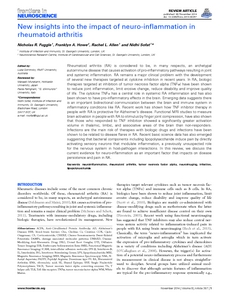Fuggle, NR; Howe, FA; Allen, RL; Sofat, N
(2014)
New insights into the impact of neuro-inflammation in rheumatoid arthritis.
Frontiers in Neuroscience, 8 (357).
ISSN 1662-4548
https://doi.org/10.3389/fnins.2014.00357
SGUL Authors: Allen, Rachel Louise Howe, Franklyn Arron Sofat, Nidhi Fuggle, Nicholas Rubek
![[img]](https://openaccess.sgul.ac.uk/107258/1.hassmallThumbnailVersion/New_insights_impact_neuro_inflammation.pdf)  Preview |
|
["document_typename_application/pdf; charset=binary" not defined]
Published Version
Download (732kB)
| Preview
|
Abstract
Rheumatoid arthritis (RA) is considered to be, in many respects, an archetypal autoimmune disease that causes activation of pro-inflammatory pathways resulting in joint and systemic inflammation. RA remains a major clinical problem with the development of several new therapies targeted at cytokine inhibition in recent years. In RA, biologic therapies targeted at inhibition of tumor necrosis factor alpha (TNFα) have been shown to reduce joint inflammation, limit erosive change, reduce disability and improve quality of life. The cytokine TNFα has a central role in systemic RA inflammation and has also been shown to have pro-inflammatory effects in the brain. Emerging data suggests there is an important bidirectional communication between the brain and immune system in inflammatory conditions like RA. Recent work has shown how TNF inhibitor therapy in people with RA is protective for Alzheimer's disease. Functional MRI studies to measure brain activation in people with RA to stimulus by finger joint compression, have also shown that those who responded to TNF inhibition showed a significantly greater activation volume in thalamic, limbic, and associative areas of the brain than non-responders. Infections are the main risk of therapies with biologic drugs and infections have been shown to be related to disease flares in RA. Recent basic science data has also emerged suggesting that bacterial components including lipopolysaccharide induce pain by directly activating sensory neurons that modulate inflammation, a previously unsuspected role for the nervous system in host-pathogen interactions. In this review, we discuss the current evidence for neuro-inflammation as an important factor that impacts on disease persistence and pain in RA.
| Item Type: |
Article
|
| Additional Information: |
© 2014 Fuggle, Howe, Allen and Sofat.
This is an open-access article distributed under the terms of the Creative Commons Attribution License (CC BY). The use, distribution or reproduction in other forums is permitted, provided the original author(s) or licensor are credited and that the original publication in this journal is cited, in accordance with accepted academic practice. No use, distribution or reproduction is permitted which does not comply with these terms. |
| Keywords: |
infection, lipopolysaccharide, neuroimaging, neuroinflammation, rheumatoid arthritis, tumor necrosis factor alpha, 1109 Neurosciences, 1702 Cognitive Science |
| SGUL Research Institute / Research Centre: |
Academic Structure > Molecular and Clinical Sciences Research Institute (MCS) > Neuroscience (INCCNS)
Academic Structure > Infection and Immunity Research Institute (INII) |
| Journal or Publication Title: |
Frontiers in Neuroscience |
| ISSN: |
1662-4548 |
| Language: |
ENG |
| Dates: |
| Date | Event |
|---|
| 6 November 2014 | Published |
|
| PubMed ID: |
25414636 |
 |
Go to PubMed abstract |
| URI: |
https://openaccess.sgul.ac.uk/id/eprint/107258 |
| Publisher's version: |
https://doi.org/10.3389/fnins.2014.00357 |
Statistics
Item downloaded times since 20 Jan 2015.
Actions (login required)
 |
Edit Item |



